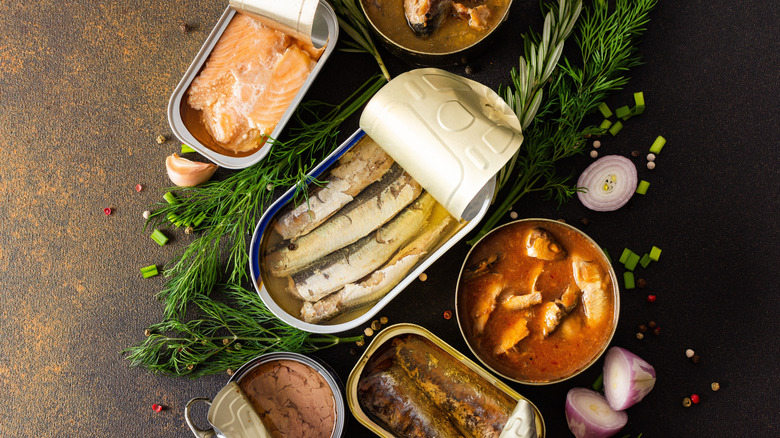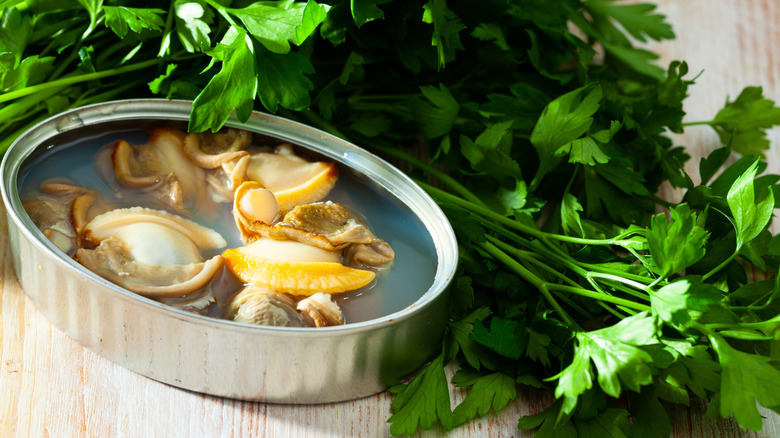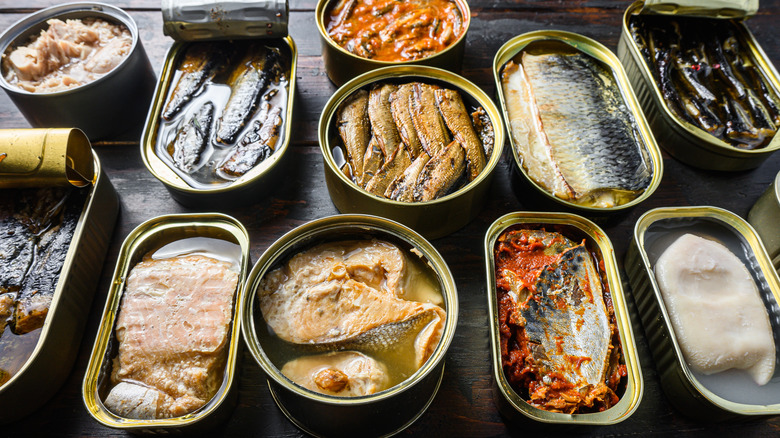The Best Way To Prepare Canned Fish Without Removing It From The Tin
Canned fish has been around since the 18th century as a practical way to preserve a food that could otherwise quickly spoil. But in recent days, canned fish has been given the gourmet treatment. Long gone are the years of highly suspect canned tuna being forced into school lunches by your parents — now you'll find scallops, salmon, cod, and clams in colorful, elegant tins on the shelves of specialty grocery stores. But if you're just getting hip to the canned fish renaissance and the only recipes you know for the ingredient involve tinned tuna, mayo, and white bread, then the concept can be intimidating. It turns out, though, that you don't even have to remove canned seafood from its tin to create something delicious. According to Chef Charlotte Langley, who is the CEO of Langley Foods, founder of Scout Canning, and Nice Cans MSC Chef Ambassador Canada, you have a few options to keep your preparation simple by leaving the fish in the can.
"The best option," Langley told Food Republic in an exclusive interview, "is to warm it in a hot water bath — gently heating your fish without the risks of direct heat." This indirect preparation method allows for safe, simple cooking without sacrificing flavor.
Soak the seafood tin in a good, hot bath
Canned seafood is already cooked and ready to eat; after being prepared and packed in oil or water, the seafood is pressure-cooked with the same method as any other canned food. So you could just open the tin and start eating — but Charlotte Langley's method is nearly as simple. You'll only need to put the closed tin into a pot or bowl of hot water for a few minutes to allow it to warm up. However, make sure that you avoid heating the can too much (like over direct flame or in the microwave), because, as Langley tells us "this could cause it to warp or release chemicals" into the food. But a hot water bath relies on a much more mild, indirect heat and keeps the seafood safe.
Once you've got the tin opened and the food warmed, Langley also had a suggestion for enhancing, but not overwhelming, the fish's flavor: Simply put, keep it simple. Just give the seafood a sprinkle of lemon zest, a splash of olive oil, or a dash of fresh herbs. "This simple preparation highlights the fish's natural flavors," said Langley.
Don't discount the deliciousness of canned seafood (there are even lots of dishes for which canned fish is actually better than fresh). And don't feel the need to get too complicated with cooking, because it's easy to come up with something tasty — as long as you start with quality in your cans.
Stick with the seafood that's MSC or ASC certified
Beyond relying on an unfussy preparation that lets the seafood shine through and elevates the flavor with fresh ingredients, Charlotte Langley emphasized the importance of using sustainably sourced selections in preparing your canned seafood the right way. "The MSC or ASC certification ensures that the seafood is sustainably harvested and traceable," said Langley, "so you know you're supporting a healthy ocean ecosystem."
MSC certification comes from a nonprofit called the Marine Stewardship Council, and ASC certification is derived from the nonprofit Aquaculture Stewardship Council. MSC-certified canned fish has to be wild-caught, sustainable, and traced to a sustainable source, while ASC-certified canned fish is reserved for seafood that has been farmed responsibly and sustainably. And the certification won't be difficult to find — the cans will be marked with a special certification label. So while Langley's in-the-can preparation method will deliver an easy, tasty result, the quality of the canned fish you buy in the first place will ensure ocean-friendly flavor.



